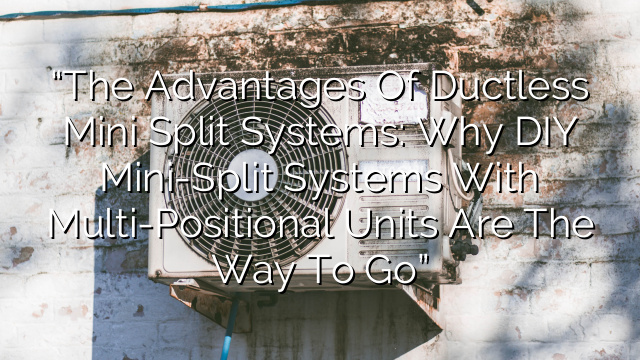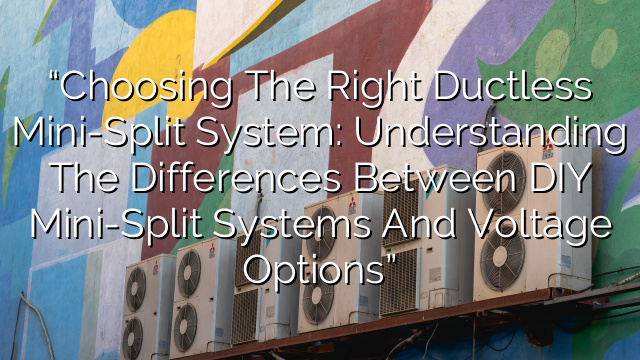Introduction
Installing a ductless mini-split system is becoming increasingly popular among homeowners. These systems offer flexible cooling and heating solutions without the need for extensive ductwork. However, choosing the right size ductless mini-split system can be a daunting task. Factors such as BTU (British Thermal Unit) and tonnage play a crucial role in determining the effectiveness and efficiency of the system. In this guide, we will discuss the importance of BTU and tonnage, and provide a step-by-step process to help you choose the right size ductless mini-split system for your needs.
What is BTU and Tonnage?
Before we delve into the steps to choose the right size ductless mini-split system, let’s understand what BTU and tonnage mean.
BTU (British Thermal Unit): BTU is a unit of measurement used to quantify the amount of energy required to raise or lower the temperature of one pound of water by one degree Fahrenheit. In the context of HVAC systems, BTU is used to measure the cooling or heating capacity of the system. The higher the BTU rating, the greater the cooling or heating capacity of the system.
Tonnage: Tonnage is a measure of the cooling capacity of an HVAC system. It represents the amount of heat the system can remove from a space within an hour. One ton is equal to 12,000 BTUs per hour. For example, a 2-ton system can remove 24,000 BTUs of heat per hour.
Step-by-Step Guide to Choosing the Right Size Ductless Mini-Split System
1.Calculate the square footage: Begin by determining the square footage of the space you want to cool or heat. Measure the length and width of the room and multiply them to get the total square footage.
2. Determine the climate zone: Depending on the region you live in, you will need different cooling and heating capacities. Climate zones are categorized based on seasonal temperature ranges. Refer to the Energy Star climate zone map to determine your zone.
3. Calculate the heat load: The heat load considers factors such as insulation, orientation, occupancy level, and appliances in the room. Energy Star provides a heat load calculator to help you estimate the amount of BTU required to cool or heat the space.
4. Consider additional factors: Remember to account for windows, ceiling height, and any other factors that could affect the cooling or heating needs of the space. Large windows or high ceilings may require additional BTU.
5. Choose the appropriate BTU: Once you have estimated the heat load, select a ductless mini-split system with the appropriate BTU rating. As a general rule, choose a system that can provide 20 BTUs per square foot of space for cooling (or 25 BTUs for hotter climates) and 30 BTUs per square foot for heating.
6. Convert BTU to tonnage: Once you have determined the BTU requirements for your space, convert it to tonnage by dividing the BTU by 12,000. For example, if you need 36,000 BTU, you will need a 3-ton system.
7. Consider zoning: If you have multiple rooms or zones that need cooling or heating, consider a multi-zone ductless mini-split system. These systems allow you to control the temperature independently in each zone, ensuring efficient and personalized comfort.
FAQs
1) Can I install a larger capacity ductless mini-split system?
It is not recommended to install a larger capacity ductless mini-split system than what is required for your space. Oversized systems can lead to frequent ON/OFF cycles, reduced energy efficiency, and decreased comfort. It is crucial to choose a system that is the right size for your cooling and heating needs.
2) Can I install a smaller capacity ductless mini-split system?
While installing a smaller capacity ductless mini-split system may seem like a cost-saving option, it can lead to inadequate cooling or heating. A system that is too small may struggle to meet the demands of the space, resulting in poor performance and increased energy consumption. It is important to choose a system that matches the cooling and heating requirements of the room.
3) Can I use a single-zone ductless mini-split system for multiple rooms?
A single-zone ductless mini-split system is designed to cool or heat a single room or zone. If you have multiple rooms that need cooling or heating, it is best to opt for a multi-zone system. These systems allow you to connect multiple indoor units to a single outdoor unit, providing individual temperature control in each zone.
4) How do I ensure the ductless mini-split system is energy-efficient?
To ensure energy efficiency, choose a ductless mini-split system with an Energy Star rating. Energy Star certified systems are designed to meet strict efficiency standards, helping you save on energy costs. Additionally, make sure the system is properly installed and maintained, and consider features such as programmable thermostats and energy-saving modes.
5) Can I install a ductless mini-split system myself?
While it is possible to install a ductless mini-split system yourself, it is recommended to hire a professional HVAC technician. Professional installation ensures proper sizing, placement, and refrigerant handling, maximizing the efficiency and longevity of the system. Additionally, professional installation may be required to qualify for manufacturer warranties.
Conclusion
Choosing the right size ductless mini-split system is essential for optimal cooling and heating efficiency. By considering factors such as square footage, climate zone, heat load, and additional factors, you can select a system with the appropriate BTU and tonnage. Investing in the right size ductless mini-split system will not only provide comfort but also help you save on energy costs in the long run. Remember to consult with a professional HVAC technician to ensure proper installation and get the most out of your ductless mini-split system.














